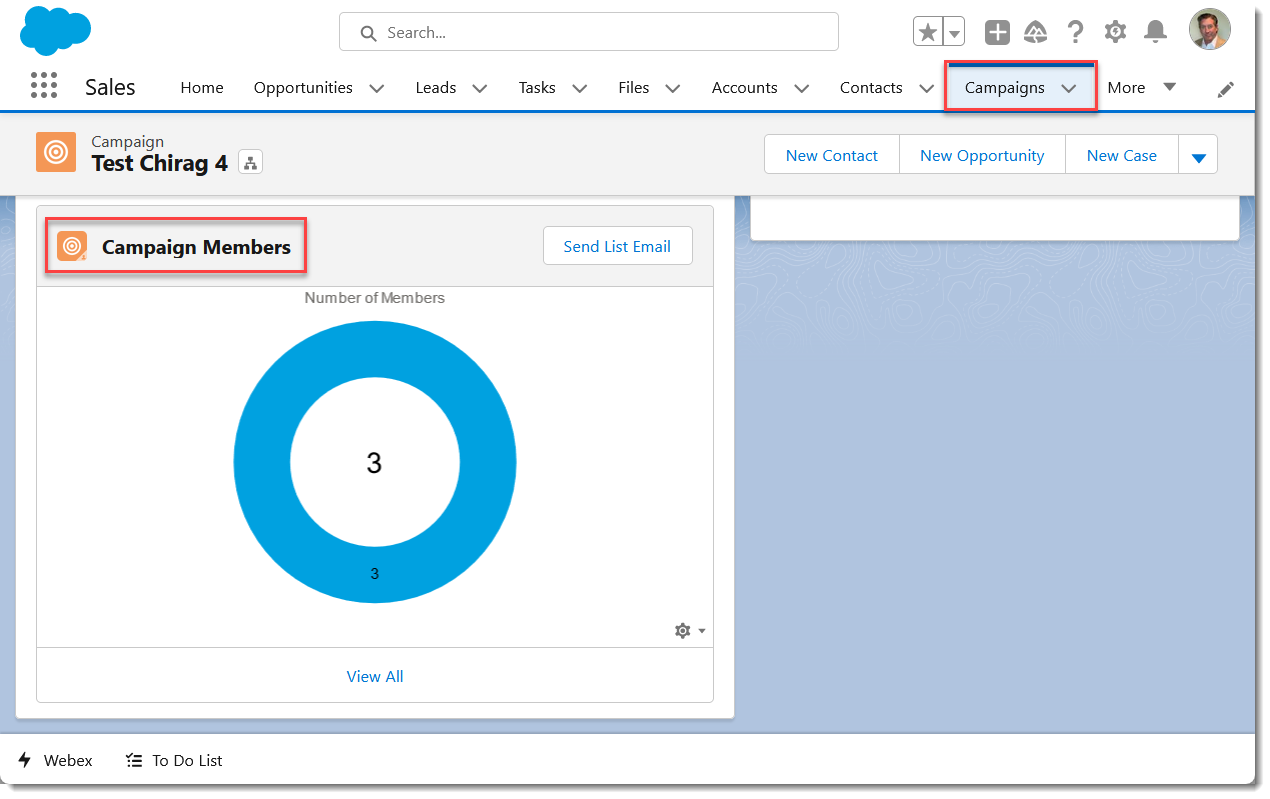- 홈
- /
- 문서

Salesforce에서 Webex로 협업
 이 문서에서
이 문서에서 피드백이 있습니까?
피드백이 있습니까?Salesforce를 나가지 않고 Webex에서 필요한 모든 것을 얻을 수 있습니다. 중요한 고객 상호 작용을 한 곳에 통합합니다. Salesforce 기록 또는 홈 페이지에서 제공하는 컨텍스트로 Webex 기능에 액세스합니다. 언제든지 메시지를 확인하고, 전화를 걸거나 Salesforce 기록을 관리합니다. Webex는 Salesforce 개체에 인바운드 및 아웃바운드 통화를 쉽게 링크할 수 있게 합니다.
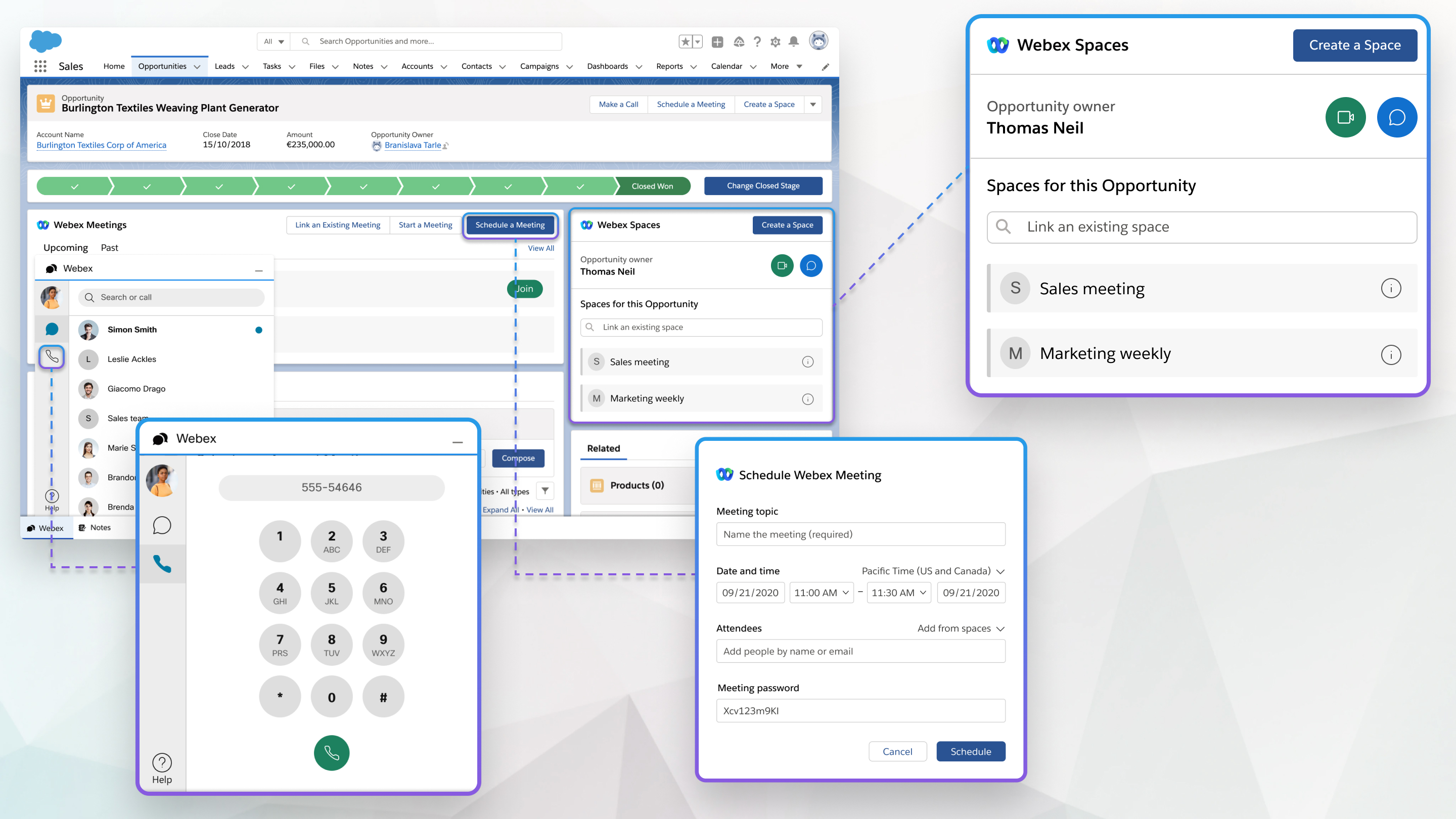
Salesforce에서 Webex에 로그인
| 1 |
Salesforce 홈 페이지의 Webex 위젯에서 로그인을 클릭합니다. |
| 2 |
이메일 주소를 입력하고 다음을 클릭합니다. |
Salesforce에서 개체에 기반한 Webex 앱 스페이스를 만들 수 있습니다. 개체는 Salesforce가 Salesforce에서 조직에 국한된 데이터를 저장할 수 있게 하는 데이터베이스 표입니다.
Salesforce에서 귀하가 멤버로 속한 모든 스페이스를 확인할 수 있습니다. Salesforce 개체에 기반한 스페이스를 만들 때 해당 개체의 소유자는 귀하가 작성하는 스페이스에 자동으로 추가됩니다.
| 1 |
Salesforce 홈 페이지에서 개체를 기회 또는 사례로 만들거나, 이미 생성한 옵션을 선택합니다. |
| 2 |
스페이스 만들기를 선택합니다. |
| 3 |
스페이스에 자동으로 이름을 지정하고 이 개체에 연계된 그룹에서 모든 그룹 멤버를 추가하려면 세부 사항으로 자동 입력을 선택합니다. |
| 4 |
개체가 변경된 후 스페이스에서 봇 알림을 수신하려면 알림 봇 포함을 선택합니다. 관리자는 알림 봇이 스페이스에 메시지를 보내는 경우 및 방법을 구성합니다. |
| 5 |
스페이스 이름을 입력하고 사용자를 스페이스에 추가한 후 만들기를 클릭합니다. |
기존의 Webex 앱 스페이스를 기회 또는 사례와 같은 Salesforce 개체에 링크하면 모든 사람이 논의되고 있는 내용을 이해할 수 있습니다.
| 1 |
Salesforce 홈 페이지에서 개체를 선택합니다. |
| 2 |
기존의 스페이스를 링크 필드에서 링크하고자 하는 스페이스의 이름을 검색합니다. |
| 3 |
링크하고자 하는 스페이스 옆에 있는 링크를 선택합니다. 다수의 스페이스를 동일한 개체에 링크할 수 있습니다. |
다른 스페이스 멤버가 포함된 스페이스 미팅을 시작하고, 개체에서 스페이스를 링크 해제, 스페이스 이름을 변경하거나, Salesforce의 모든 스페이스에서 사용자를 추가하고 제거할 수 있습니다.
| 1 |
Salesforce 홈 페이지에서 관리하고자 하는 스페이스와 링크된 개체를 선택합니다. |
| 2 |
정보 i 기호를 선택합니다. |
| 3 |
선택:
화상 통화 및 채팅 아이콘은 개체 소유자 옆에도 나타나며, 이를 사용하여 소유자에게 직접 연락할 수 있습니다. |
| 4 |
저장을 선택합니다. |
개체와 관련된 Webex 미팅을 예약할 수 있습니다.
| 1 |
Salesforce 홈 페이지에서 미팅을 예약하고자 하는 개체를 선택합니다. |
| 2 |
미팅 예약하기를 선택합니다. |
| 3 |
미팅 주제를 입력합니다. |
| 4 |
미팅에 대한 날짜 및 시간을 선택합니다. |
| 5 |
미팅에 첨부 파일을 추가합니다. 스페이스 또는 그룹에서 추가를 선택하여 이 개체에 링크한 스페이스나 그룹 중 하나에 있는 모든 사용자를 추가합니다. |
| 6 |
캘린더를 사용하여 추가하는 참석자에 대한 대화 가능 여부를 확인합니다. 조직 외부의 참석자에 대한 대화 가능 여부는 확인할 수 없습니다. |
| 7 |
예약을 선택합니다. 미팅 정보가 나타납니다. |
|
Salesforce 홈 페이지에서 다음 중 하나를 선택합니다.
|
개체와 관련된 내용을 논의해야 하는 경우에 캘린더에서 기회 또는 사례와 같은 Salesforce 개체에 기존의 Webex 미팅을 링크할 수 있습니다.
| 1 |
Salesforce 홈 페이지에서 개체를 선택합니다. |
| 2 |
기존의 미팅 링크를 선택합니다. |
| 3 |
시작 날짜 및 종료 날짜 필드를 사용하여 해당 기간에 발생한 모든 Webex 미팅을 표시합니다. |
| 4 |
링크하고자 하는 미팅 옆에 있는 링크를 선택합니다. 다수의 Webex 미팅을 동일한 개체에 링크할 수 있습니다. |
| 1 |
Salesforce 홈 페이지에서 미팅을 녹화한 개체를 선택합니다. |
| 2 |
과거를 선택하고 녹화 대화 내용을 선택합니다. |
| 1 |
Salesforce의 페이지에서 Webex를 선택합니다. |
| 2 |
통화를 클릭하고 전화 번호를 입력한 후 오디오 통화를 선택합니다. 전화 번호를 입력하기 시작하면 일치하는 번호의 Salesforce 연락처가 나타납니다. |
| 3 |
Webex 앱에서 전화를 걸고자 하는지 확인합니다. |
Salesforce 개체에 연계된 모든 연락처에게 전화할 수 있습니다.
| 1 |
Salesforce 홈 페이지에서 전화하고자 하는 연락처와 연계된 개체를 선택합니다. |
| 2 |
전화하고자 하는 연락처에 대해 전화 걸기를 선택하고 오디오 통화를 선택합니다. |
인바운드 또는 아웃바운드 통화를 실행하는 동안 Salesforce 기록을 관리할 수 있습니다. 새로운 연락처 또는 리드인 사용자와 대화하고 있는 경우, 해당 연락처를 데이터베이스에 추가하는 동시에 관련된 개체를 만들 수 있습니다.
| 1 |
통화하고 있는 사용자에 대해 Salesforce 기록이 존재하지 않는 경우, 새 연락처 또는 새 리드를 선택합니다. 연락처 또는 리드의 이름은 기록이 이미 존재하는 경우에 자동으로 나타납니다. |
| 2 |
연락처/리드 필드에서 기록을 검색하고 선택하여 Salesforce 기록에 링크합니다. |
| 3 |
케이스 또는 기회 등 이 케이스와 관련된 새로운 개체를 만들려면 새 를 선택합니다. |
| 4 |
관련 필드에서 개체를 검색하고 선택하여 연락처 또는 리드에 링크합니다. |
| 5 |
통화와 관련된 제목 및 코멘트를 추가할 수도 있습니다. |
| 6 |
활동 탭을 사용하여 이 연락처 또는 리드에 대한 통화 내역을 확인합니다. 연락처의 이름을 선택하여 계정 페이지를 열 수 있습니다. 아직 계정이 없는 경우, 대신 연락처 페이지가 나타납니다. |
| 7 |
추가 정보 탭을 사용하여 이 연락처나 리드와 관련된 모든 개체를 확인합니다. 개체를 선택하여 관련된 페이지를 열 수 있습니다. 관리자는 추가 정보 탭에 나타나는 내용을 제어합니다. |
Salesforce용 Webex 통합의 통화 기록 기능을 사용하여 최근 전체 로그 및 부재 중 전화, 한 번에 한 번 또는 여러 통화를 기록하고 통화 기록 항목에서 직접 통화를 반환할 수 있습니다.
최근 통화 및 부재중 전화 검토
최근 통화 및 부재중 통화를 검토하려면:
- 페이지 보기의 하단에 있는 Webex 유틸리티 구성 요소를 선택하고 전화 핸드셋 아이콘을 선택하여 통화 기록을 표시합니다.
- 모든 통화를 스크롤하거나 부재중 통화 탭을 선택하여 부재중 통화를 볼 수 있습니다.부재중 전화는 빨간색 굵은 글꼴의 모든 통화 탭에도 표시됩니다.
- 연락처에 대한 수신/발신 통화 목록을 포함하여 추가 세부 사항을 확인하려면 통화 항목을 선택합니다.
통화 로그
개별 통화를 로그하려면:
- 페이지 보기의 하단에 있는 Webex 유틸리티 구성 요소를 선택하고 전화 핸드셋 아이콘을 선택하여 통화 기록을 표시합니다.
- 관심이 있는 통화 로그 항목 위에 마우스를 올리고 항목 옆에 있는 로그 를 선택합니다.이미 로그인한 통화 항목은 통화 로그 보기의 항목 옆에 있는 작은 폴더 아이콘으로 표시됩니다.
- 통화 로그 항목에 원하는 세부 정보를 입력하고 저장을 선택합니다.발신자가 있는 경우 발신자는 자동으로 Salesforce 연락처 또는 리드와 일치합니다.
- 앱 및 항목 검색 상자에서 작업 을 검색하거나 작업 탭을 추가한 경우 영업 앱 내비게이션 바에서 선택하고 작업 유형 목록에서 Webex 통화 로그 를 선택하여 로그인한 통화를 볼 수 있습니다.
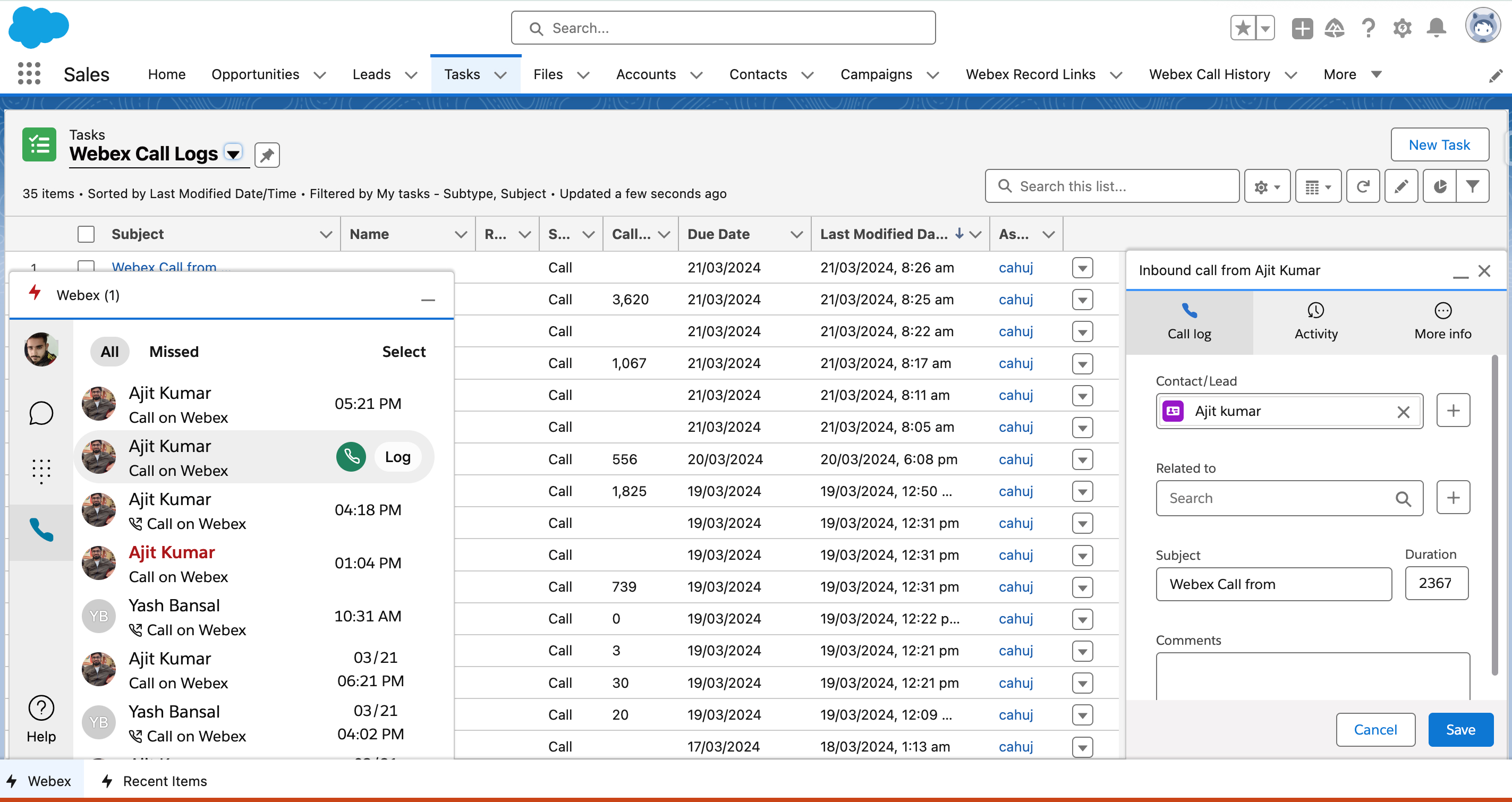
여러 통화 로그
여러 통화를 기록하려면:
- 페이지 보기의 하단에 있는 Webex 유틸리티 구성 요소를 선택하고 전화 핸드셋 아이콘을 선택하여 통화 기록을 표시합니다.
- 선택을 선택하고 로그하고자 하는 통화 옆에 있는 체크 박스를 토글한 후 여러 통화 로그를 선택합니다.
- 통화가 있는 경우, 통화가 기록되고 기존의 Salesforce 연락처 또는 리드에 자동으로 일치합니다.
- 앱 및 항목 검색 상자에서 작업 을 검색하거나 작업 탭을 추가한 경우 영업 앱 내비게이션 바에서 선택하고 작업 유형 목록에서 Webex 통화 로그 를 선택하여 로그인한 통화를 볼 수 있습니다.로그 항목을 보기 위해 선택할 수 있는 Salesforce 알림도 수신하게 됩니다.
기록에서 통화 반환
통화 기록에서 통화를 반환하려면:
- 페이지 보기의 하단에 있는 Webex 유틸리티 구성 요소를 선택하고 전화 핸드셋 아이콘을 선택하여 통화 기록을 표시합니다.
- 전화하고자 하는 연락처 위에 마우스를 올리고 녹색 전화 아이콘을 선택하여 전화를 겁니다.
예약된 Webex Webinars에서 참석자 데이터를 가져오고 Salesforce 캠페인에도 첨부할 수 있습니다.
Webex 웨비나에서 참석자 데이터를 가져오려면:
- 홈 페이지에서 Webex 웨비나 구성 요소를 찾고 웨비나를 만든 Webex 도메인을 선택합니다.
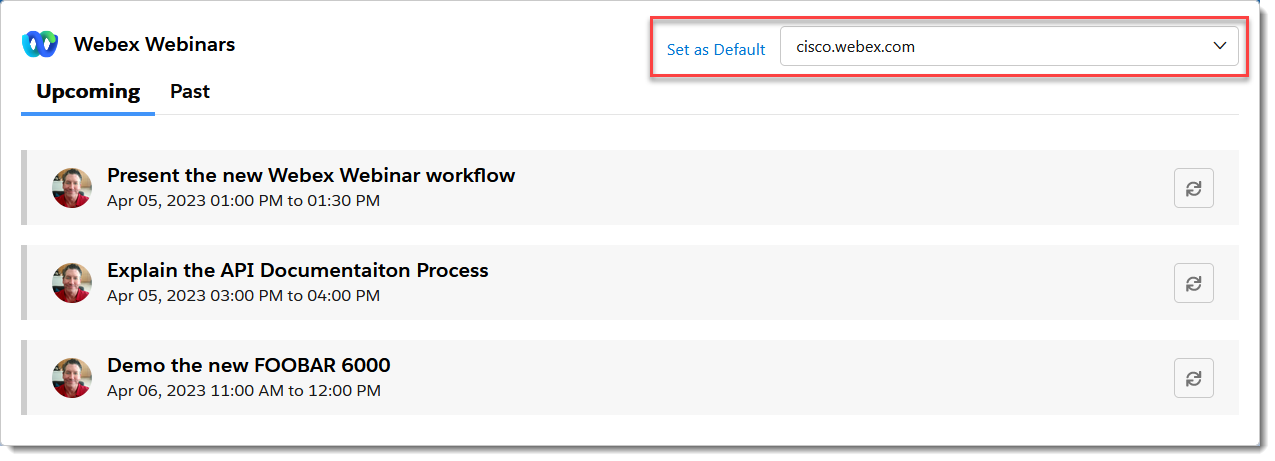
- 예정된 또는 지난 웨비나 중에서 선택합니다.
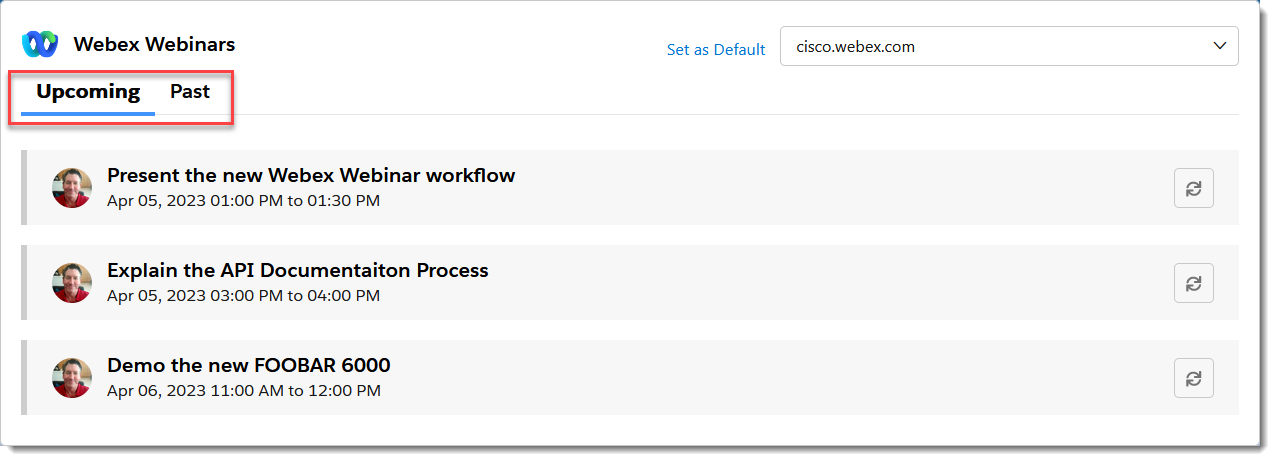
- 가져오려는 데이터가 있는 웨비나 옆에 있는 가져오기 버튼을 클릭합니다.
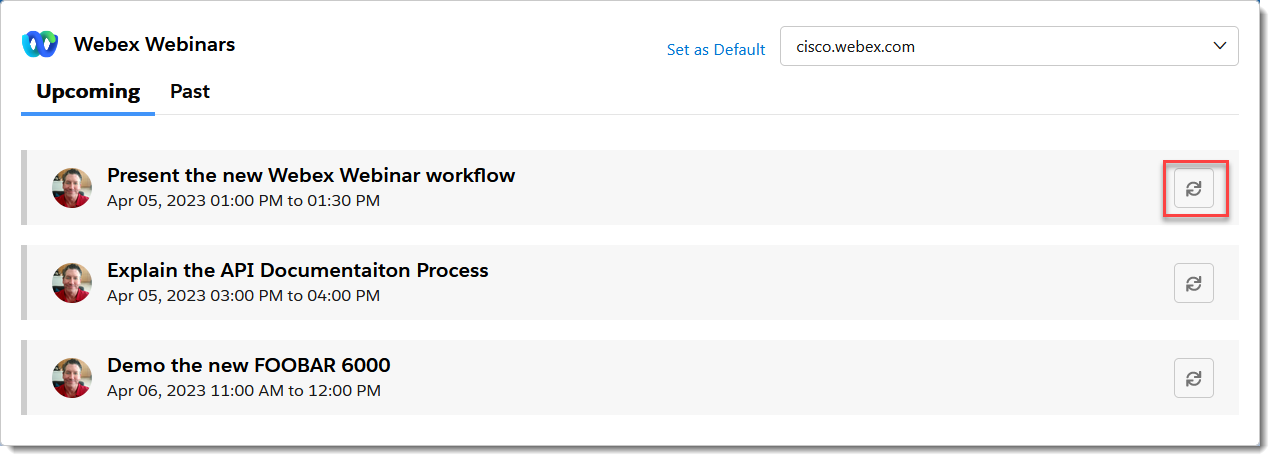
- 가져오기 대화 상자에서 필요한 경우 기존 캠페인을 검색하거나 + 를 클릭하여 웨비나 데이터를 가져오려는 새 캠페인을 만듭니다.
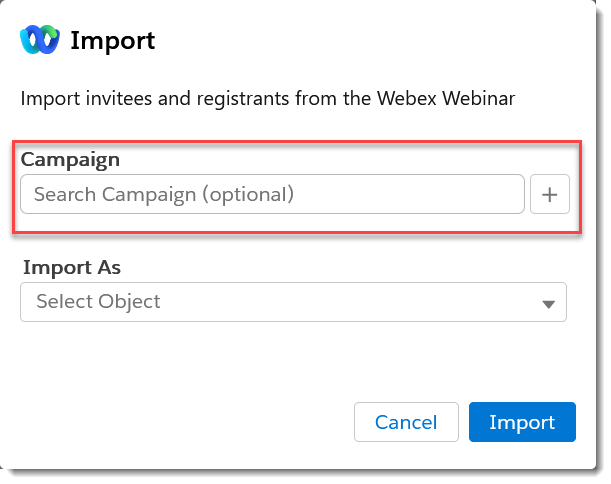
참고: 새로운 캠페인을 만들려면 적합한 Salesforce 권한이 필요합니다.
- 예정된 웨비나에서 데이터를 가져오는 경우, 다른 이름으로 가져오기 에서 Salesforce 개체의 유형을 선택한 후 가져오기를 클릭합니다.
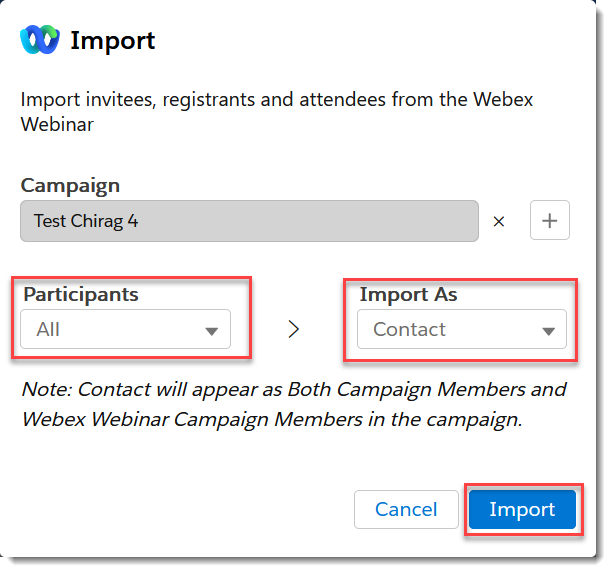 아래 참고 다른 이름으로 가져오기 는 관리자가 매핑한 가져오기 설정에 따라 가져온 정보가 캠페인에 나타나는 위치를 나타냅니다.
아래 참고 다른 이름으로 가져오기 는 관리자가 매핑한 가져오기 설정에 따라 가져온 정보가 캠페인에 나타나는 위치를 나타냅니다. - 과거 웨비나에서 데이터를 가져오는 경우, 가져오려는 웨비나 참가자 기록의 상태(모두, 참석함 또는 아니요 표시)를 선택한 후 다른 이름으로 가져오기에서 Salesforce 개체의 유형을 선택할 수 있습니다. 가져오기를 클릭합니다.
 아래 참고 다른 이름으로 가져오기 는 관리자가 매핑한 가져오기 설정에 따라 가져온 정보가 캠페인에 나타나는 위치를 나타냅니다.
아래 참고 다른 이름으로 가져오기 는 관리자가 매핑한 가져오기 설정에 따라 가져온 정보가 캠페인에 나타나는 위치를 나타냅니다.
- 예정된 웨비나에서 데이터를 가져오는 경우, 다른 이름으로 가져오기 에서 Salesforce 개체의 유형을 선택한 후 가져오기를 클릭합니다.
- 가져오기 작업이 완료되면 데이터를 가져오고 있음을 나타내는 배너가 나타나고 알림을 수신합니다.

- 가져오기 프로세스는 성공, 부분적으로 실패 및 실패한 가져오기를 포함하여 모든 가져오기에 대해 쉼표로 구분된 값(CSV) 보고서 파일을 생성합니다. 보고서는 각 실패 또는 성공을 자세히 설명하고 성공적으로 가져온 각 행에 대해 매핑된 Salesforce 레코드에 대한 링크를 포함합니다. 보고서 다운로드 를 선택하여 CSV 보고서를 다운로드하고 검토합니다.
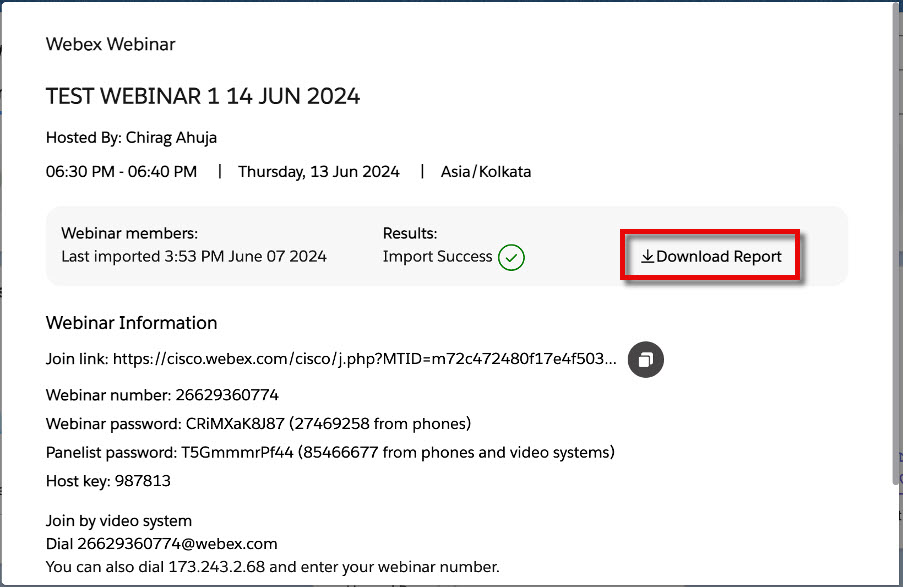
-
웨비나 데이터는 선택된 Salesforce 개체 유형으로 가져오고, 관리자가 웨비나 데이터 가져오기를 구성한 방법에 따라 Salesforce 캠페인 탭의 Webex Webinar 캠페인 멤버 또는 캠페인 멤버 목록에서 사용할 수 있습니다.
위의 예제에서 웨비나 데이터는 Salesforce 연락처 개체로 가져오고, 참고로 설명된 대로 캠페인 멤버 및 Webex 웨비나 캠페인 멤버 목록(캠페인 멤버 목록만 아래에 표시) 모두에서 사용할 수 있습니다.
